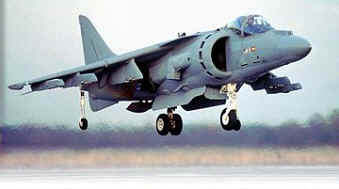
STOVL Propulsion

AV-8B "Harrier" in Hover mode
STOVL is an acronym for Short Take-off and Vertical Landing. This refers to a special breed of aircraft which have the ability to create thrust in a vertical direction as opposed to the conventional horizontal direction by most planes. By directing thrust downwards, the aircraft has the ability to both takeoff and land without a runway.
First you have to know how conventional jet aircraft work. For conventional aircraft, the jet engine pulls air in, burns fuel to heat up the air, and exhausts the air out the back at a much higher velocity.
The first generation STOVL aircraft is the AV-8 Harrier (pictured above). This aircraft creates its vertical thrust using ducts that redirect a portion or the main jet engine's thrust downwards. One of these ducts can be seen above on the side of the plane just behind the visible jet intake (the black half-circle).
The second generation STOVL aircraft, the US Marine Corps version of the Joint Strike Fighter (JSF), has two different methods to create this lift. There were two experimental aircraft developed, built, and tested to try to win this government contract. The Boeing company aircraft used the same method of creating vertical thrust by using thrust vectoring nozzles. The Lockheed Company, however, has developed a new way to create this thrust. The Lockheed JSF used a rear engine nozzle which could twist and turn down 90-degrees vertically in combination with a shaft-driven fan near the front of the plane (see video section at bottom of page). This shaft is driven by the main jet engine. It was this new and innovative design that, at least partially, won Lockheed-Martin the contract for the JSF.
In one word, flexibility. This plane can do anything a conventionally wing-borne aircraft can do in regular flight, but this plane also has the ability to make remote landings and remote attacks. Think about a new battle field where the area has not been secured yet. Without an airfield, regular planes can not operate from there, but a STOVL aircraft could conceivable do that.
The reason that STOVL is some limited is because it is highly inefficient, for two reasons. The first and most important reason is that it takes a tremendous amount of fuel to takeoff vertically, which is the reason most STOVL aircraft use "short" takeoffs as opposed to vertical ones (a "short" take off is a hybrid between conventional wing borne flight and vertical STOVL flight). The second reason is that fitting a plane with the hardware to takeoff vertically is expensive to implement and service. The AV-8B Harrier can only hover for 60 seconds before the hot exhausting gases begin to take their toll on the aircraft frame and engine.
The main use for STOVL is presently with the US attack plane the AV-8B Harrier and the British Sea Harrier. These planes are getting obsolete now and the next generation STOVL aircraft, the JSF (see article above), has already undergone testing. This STOVL aircraft will be used by the US Marine Corps, the British Royal Navy and Air Force.
Boeings AV-8B "Harrier", the first generation of STOVL Aircraft
Government presentation explaining need for Joint Strike Fighter